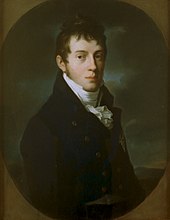Carl Friedrich (Saxe-Weimar-Eisenach)

Carl Friedrich von Sachsen-Weimar-Eisenach (* February 2, 1783 in Weimar ; † July 8, 1853 ibid) was Grand Duke of Sachsen-Weimar-Eisenach .
Life


Carl Friedrich was the eldest son of the Duke and later Grand Duke Karl August von Sachsen-Weimar-Eisenach (1757–1828) from his marriage to Luise (1757–1830), daughter of Landgrave Ludwig IX. from Hessen-Darmstadt . He was considered the mother's declared darling, while the father preferred the younger brother Bernhard . After completing his training, for which Johann Gottfried Herder was responsible, the prince went on his grand tour that took him to France and Russia.
On August 3, 1804, he married the Grand Duchess Maria Pavlovna (1786-1859), daughter of the Russian Tsar Paul I, in Saint Petersburg . and his second wife Princess Sophie Dorothee von Württemberg (1759–1828). For the couple's move into Weimar, Schiller wrote Die Huldigung der Künste . Carl Friedrich spent his hereditary princehood partly in Weimar and partly in Saint Petersburg. On June 14, 1808 he received the Order of the Black Eagle from the Prussian King . After the death of his father on June 4, 1828 he became the reigning Grand Duke.
In terms of the principles of administration, Carl Friedrich continued his father's policy, but severely restricted the court . Under the influence of his wife, the first savings banks in the duchy as well as numerous welfare institutions were established from 1821. Carl Friedrich promoted agriculture, trade and commerce, joined the German Customs Union in 1834 and concluded a contract with other Thuringian duchies and Prussia to build the Thuringian Railway from Halle (Saale) via Weimar to Eisenach . He was able to assert his route against the Prussian.
On April 6, 1842, the Prussian king appointed him major general.
As a result of the revolution of 1848 , the constitution of 1816 was further liberalized. In March 1848, there were tumults in the castle courtyard because the population demanded the appointment of liberal ministers. Ernst Christian August von Gersdorff had to be dismissed, and the following cabinet issued numerous ordinances that also restricted the rights of the Grand Duke.
Carl Friedrich was completely in the shadow of his father. Although he was more economical than this, he had no feeling for the trends of the new time. The initiatives for a new cultural beginning almost always came from his gifted wife. The government leaned on Prussia: two princesses were married to Hohenzollern princes, and officers were trained at Prussian academies.
His coffin is in the Princely Crypt at the Weimar Historic Cemetery .
progeny
Carl Friedrich had the following children from his marriage:
- Paul Alexander Carl Constantin Friedrich August (1805-1806)
- Marie (1808–1877)
- ⚭ 1827 Prince Carl of Prussia (1801–1883)
- Augusta (1811-1890)
- ⚭ 1829 King Wilhelm I of Prussia (1797–1888)
- Carl Alexander (1818–1901), Grand Duke of Saxe-Weimar-Eisenach
- ⚭ 1842 Princess Sophie of the Netherlands (1824–1897)
literature
- Ernst Wülcker : Karl Friedrich (Grand Duke of Saxony-Weimar-Eisenach) . In: Allgemeine Deutsche Biographie (ADB). Volume 15, Duncker & Humblot, Leipzig 1882, pp. 355-358.
- Conversations lexicon of the latest times and literature, FA Brockhaus Verlag Leipzig, second volume, Leipzig 1833, p. 675 f. ( Digitized version )
- Karl Helmrich: History of the Grand Duchy of Saxony-Weimar-Eisenach , p. 132 ff.
- Detlef Jena: Carl Friedrich. Grand Duke of Saxony-Weimar-Eisenach , Verlag Friedrich Pustet, Regensburg 2013. ISBN 978-3-7917-2520-8 .
- Kurt von Priesdorff : Soldier leadership . Volume 6, Hanseatische Verlagsanstalt Hamburg, undated [Hamburg], undated [1938], DNB 367632810 , pp. 113-114, no. 1740.
Web links
Individual evidence
- ↑ The spelling “Carl Friedrich” follows the contemporary portraits, the equally contemporary coin with his likeness and the basic biography of Detlef Jena.
| predecessor | Office | successor |
|---|---|---|
| Karl August |
Grand Duke of Saxe-Weimar-Eisenach 1828 - 1853 |
Carl Alexander |
| personal data | |
|---|---|
| SURNAME | Carl Friedrich |
| ALTERNATIVE NAMES | Saxe-Weimar-Eisenach, Carl Friedrich von (full name) |
| BRIEF DESCRIPTION | Grand Duke of Saxe-Weimar-Eisenach (1828-1853) |
| DATE OF BIRTH | February 2, 1783 |
| PLACE OF BIRTH | Weimar |
| DATE OF DEATH | July 8, 1853 |
| Place of death | Weimar |
